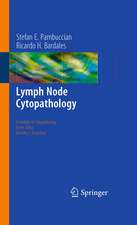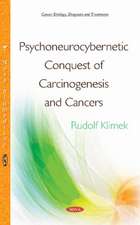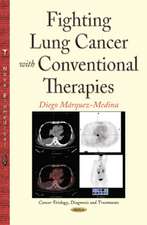Chemical Carcinogenesis 2: Modulating Factors
Editat de A. Columbano, F. Feo, P. Pani, R. Pascaleen Limba Engleză Paperback – 5 noi 2012
Preț: 391.58 lei
Preț vechi: 412.19 lei
-5% Nou
Puncte Express: 587
Preț estimativ în valută:
74.93€ • 78.43$ • 62.36£
74.93€ • 78.43$ • 62.36£
Carte tipărită la comandă
Livrare economică 26 martie-01 aprilie
Preluare comenzi: 021 569.72.76
Specificații
ISBN-13: 9781461366423
ISBN-10: 1461366429
Pagini: 668
Ilustrații: XII, 653 p.
Dimensiuni: 156 x 244 x 35 mm
Ediția:Softcover reprint of the original 1st ed. 1991
Editura: Springer Us
Colecția Springer
Locul publicării:New York, NY, United States
ISBN-10: 1461366429
Pagini: 668
Ilustrații: XII, 653 p.
Dimensiuni: 156 x 244 x 35 mm
Ediția:Softcover reprint of the original 1st ed. 1991
Editura: Springer Us
Colecția Springer
Locul publicării:New York, NY, United States
Public țintă
ResearchCuprins
Nuclear Oncogenes as Transcription Factors.- Control of Hepatocyte Growth by Positive and Negative Growth Regulators and Mitogenic Triggers: Implications for Hepatic Neoplasia.- Cell Cycle Dependent Regulation of Poly(ADP-Ribose) Polymerase Gene Expression.- Different Expression of Cell Cycle Related Genes During Liver Regeneration and Liver Hyperplasia.- S-Adenosylmethionine Content, DNA Methylation and Gene Expression in Regenerating Liver.- Gene Activation and Deactivation During Multistage Hepatocarcinogenesis in the Rat.- Biochemical and Molecular Perturbations Induced in Preneoplastic Tissue by a S-Adenosyl-L-Methionine Load.- Alterations of Cell Surface Receptors and Expression of Cellular Oncogenes in the Liver of Rats Fed a Hypolipidemic Peroxisome Proliferator.- Growth Hormone-Regulated Expression of c-myc Gene During sex-Differentiated Promotion of Rat Liver Carcinogenesis.- In Situ Hybridization of Ha-Ras During Rat Liver Carcinogenesis.- Mutations in the H-Ras Proto-Oncogene in Early Precancerous Liver Lesions of the B6C3F1 Mouse.- Transformation of Human Epithelial Cells by Recombinant Human Papillomavirus DNA Associated with Cervical Cancer.- Cancer Families and Susceptibility to Cancer.- Cancer Syndromes in Humans.- Case-Control Studies on Cancer Risk in G6PD-Deficient Male Populations.- Genetic Susceptibility to Murine Hepatocarcinogenesis.- MHC-Linked Genes Controlling Growth and Reproduction Influence the Susceptibility to Diethylnitrosamine-Induced Carcinogenesis.- Metabolic Aberrations and Metamorphosis During Chemical Carcinogenesis.- Persistent Rat Liver Nodules Differ from Normal Liver, Regenerating Liver and Early Nodules both in Terms of Proteins of the Nuclear Matrix and Chromatin Condensation.- Intracellular Na+, K+, H+ and Cl? Activitiesand Membrane Potentials During the 4-Dimethylaminoazobenzene-Induced Rat Hepatocarcinogenesis.- Analysis of the Effects of Modifying Agents on Proliferation and Enzyme Phenotype in Focal Preneoplastic and Neoplastic Liver Lesions in Rats.- Epidermal Growth Factor-Induced Cell Proliferation and EGF Binding in Preneoplastic Foci in The Rat Liver.- The Different Calcium Requirements of the Mitogenic Effects Elicited in Primary Neonatal Rat Hapatocytes by the Diterpene Phorbol Esters 12-O-Tetradecanoylphorbol-13-Acetate and Sapintoxin A.- Glucose-6-Phosphate Dehydrogenase Molecular Forms in Different Experimental Models of Hepatic Cell Proliferation.- Estrogen Dependent Growth of a Rat Pituitary Tumor (MtT/F84).- Deterministic Coupling Between Cellular Bioenergetics, Cholesterol Synthesis, cell Proliferation and Cancer.- Dolichyl Phosphate as a Regulator of Cell Growth.- Regulation of Cholesterol Metabolism in Normal and Malignantly Transformed Tissue in Vivo.- Cholesterol Metabolism and Proliferative Processes.- Serum LCAT and Lipid Levels in grc-- Bearing Rats with Liver Cancer.- Covalent Modification of Proteins by Farnesol and the Control of Cell Proliferation.- Repeated Treatments with a Low HNE Concentration Affect K562 Cell Proliferation.- Arachidonic Acid Enrichment Augments the Malonildialdehyde Production in Yoshida AH-130 Hepatoma Cells.- Modulation of Phosphatidylinositol-4,5-Diphosphate (PIP2)-Phospholipase C Activity by 4-Hydroxyalkenals.- The Role of Hepatic Metabolism in Sex Differentiation of Chemical Hepatocarcinogenesis in the Rat.- Changes of Rat Liver Glutathione Peroxidase, Glutathione Reductase and Glutathione Transferase 7–7 by Lead Nitrate Treatment.- High Affinity P-450 Form for the Metabolic Activation of DEN in Liver of Acetone-Induced Ratsbut not of Hamsters.- Genotoxicity of Chloroethanes and Structure Activity Relationships.- Genetical and Biochemical Studies on Three Halogenated Ethanes.- “In Vivo” Interaction of Methionine and Cysteine Sulfur with Rat Liver tRNA.- Synthesis and Secretion of Cathepsin D in Normal And Tumor Human Cells.- Relationship Between Cell Proliferation and Cell Death.- An in Vitro Model for Apoptosis: Uptake and Degradation of Apoptotic Bodies.- Protein Catabolism and Apoptosis in AH-130 Hepatoma Cells and in the Host Rat Liver.- Protein synthesis During Programmed (Physiological) Cell Death.- Role of Tissue Transglutaminase in the Formation of Apoptotic Bodies.- The Induction of Apoptosis in Human Malignant Keratinocytes by Antisense DNA to Retinoid Receptors: Keys to the Function of Apoptosis and Vitamin A.- Cell Death and Cell Proliferation in Experimental Hepatocarcinogenesis.- Cell Death and Proliferation in Opisthorchis Viverrini-DHPN Induced Carcinogenesis in the Syrian Hamster Hepato-Pancreatic Axis.- Ethionine-Induced Atrophy of Rat Parotid Glands Involves Apoptosis of Acinar Cells: Implications for Chemical Carcinogenesis.- Apoptotic Effect of Skin Tumor Promoters on Thymocytes: Cell Death as a Possible Trigger for the Induction of Promotability (Conversion).- Chemoprevention of Rat Liver Carcinogenesis by S-Adenosylmethionine: Role of Remodeling and Apoptosis.- The Occurrence of Apoptosis in Tumors and its Effect on Neoplastic Development.- Stimulus Dependent Phenotypic Diversity in the Resistant Hepatocyte Model.- Effects of 5-Azacytidine (5-AzC), 5-Bromodeoxyuridine (Brdu) and Diethyldithiocarbamate (DEDTC) on Diethylnitrosamine (DEN)-Induced Carcinogenesis in Rats.- Modulation by a Choline Devoid Diet of Repair of Chemical Damage in Liver DNA.- Is theBeta-Blocker DL-Zami 1305 a Tumor Promoter for Rat Liver?.- Amplifying Effects of uracil on Multi-stage Bladder Carcinogenesis in Rats.- Bombesin and Hepatocyte Proliferation.- Inhibition of Growth of Breast Cancer in Vitro by the Ribosome-Inactivating Protein Saporin 6.- Determination of PAH-DNA Adducts in Lung Tissue of Cancer Patients.- Theoretical Studies of Flavone Acetic Acids.
















